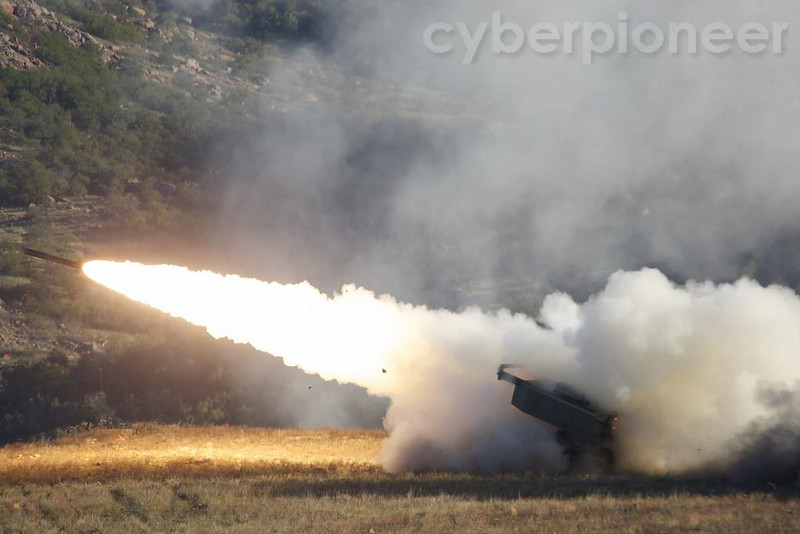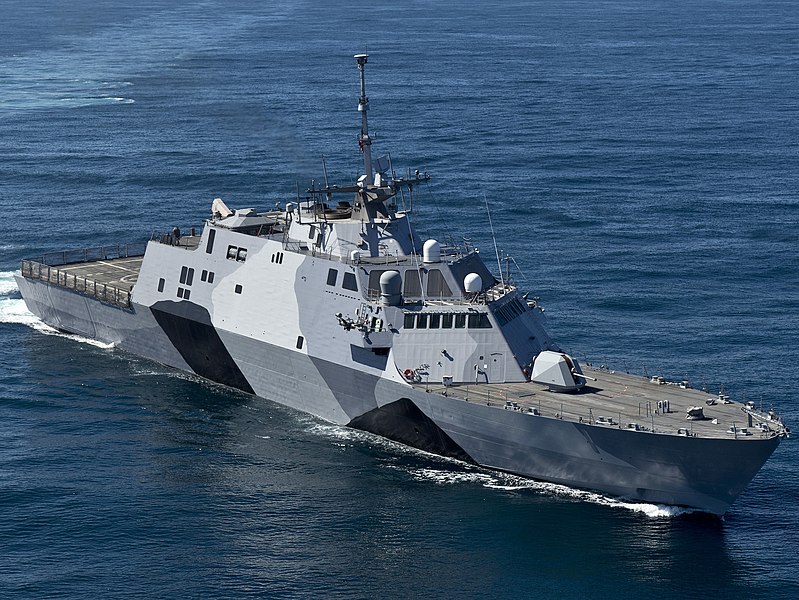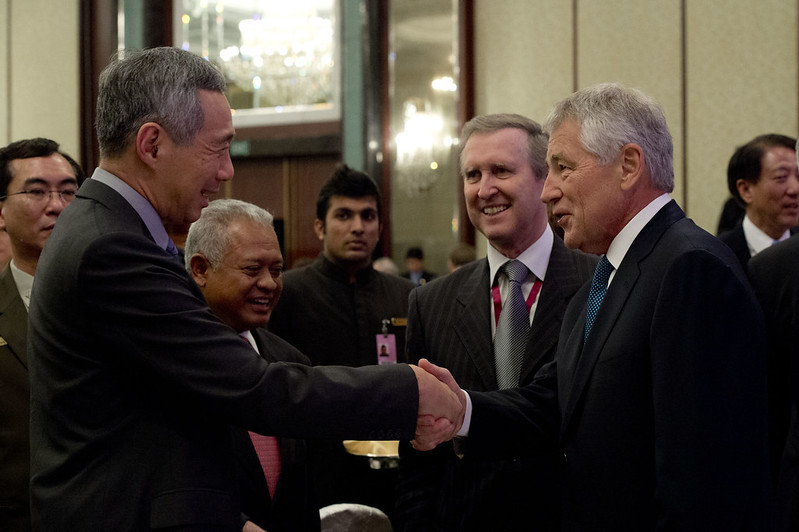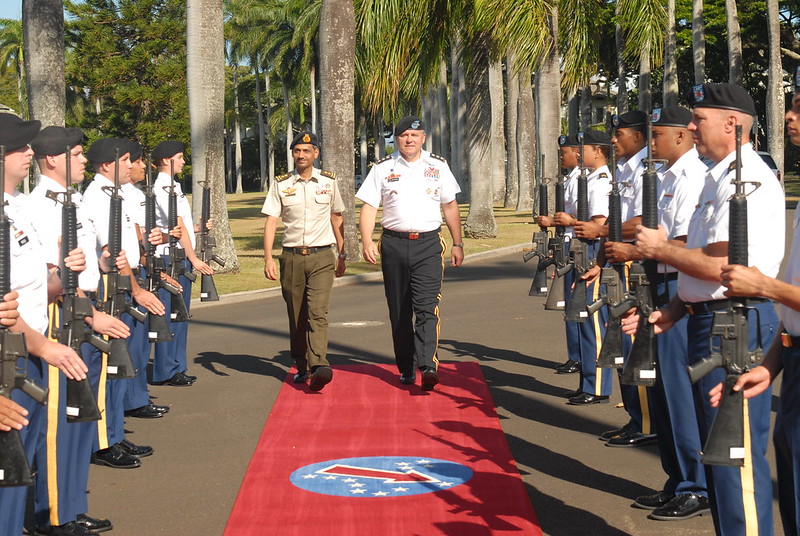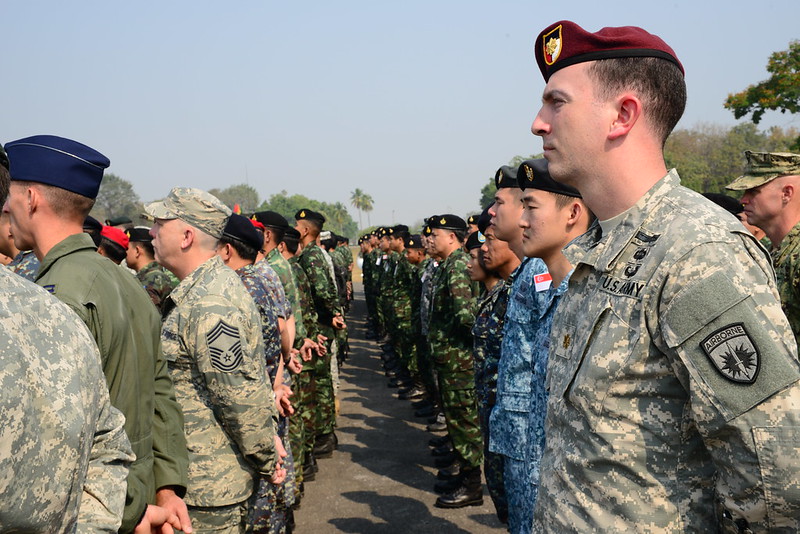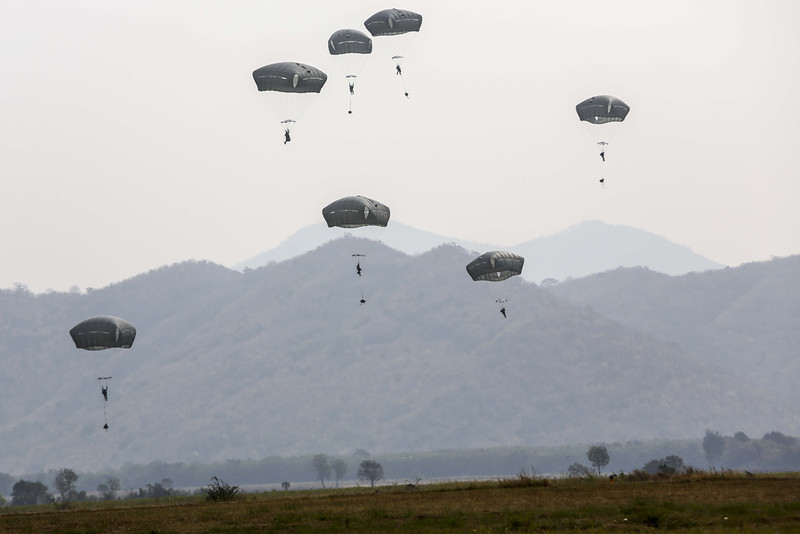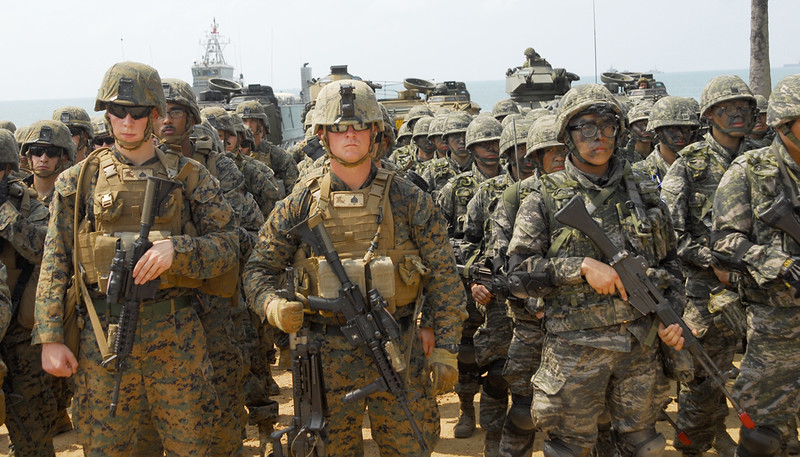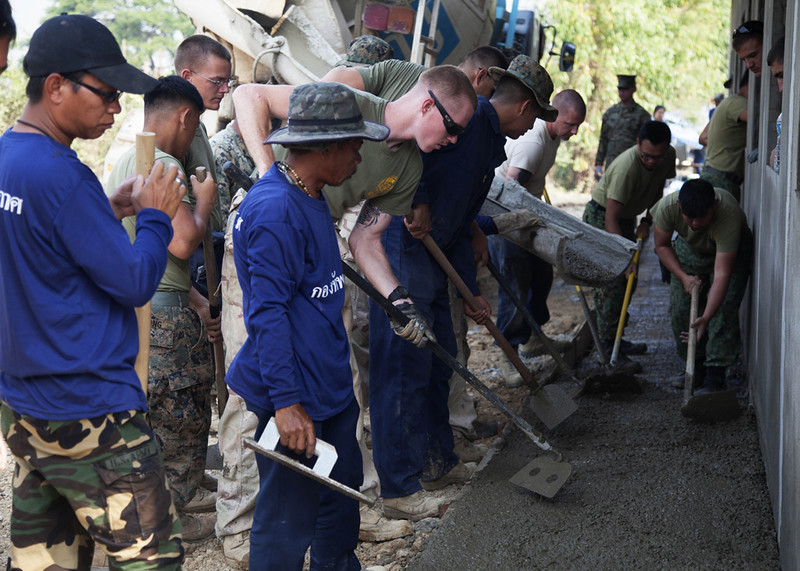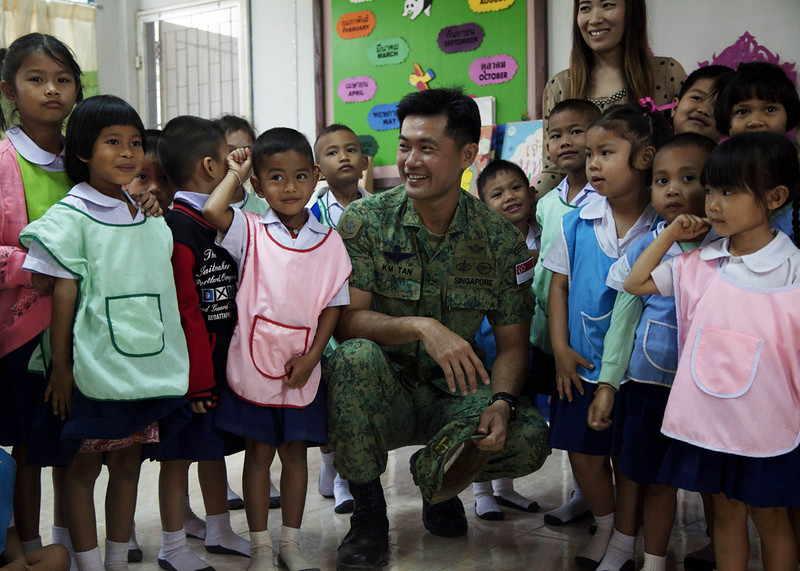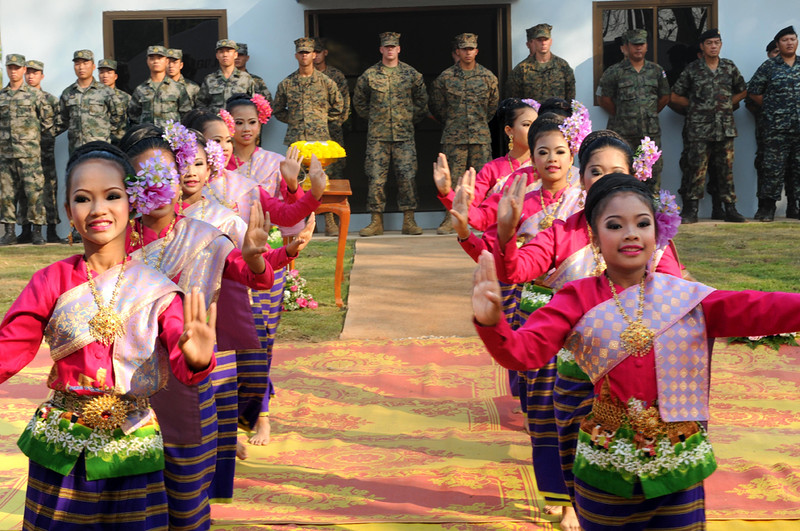Fellowship of the Geopolitical Chess Masters (Part 1 of 2)
As Mao Zedong once said, political power grows out of the barrel of a gun. Below, a 1970s picture of two conscripts pointing a M16S1. Hard power, like guns, tanks, fighters jets, warships and submarines, are the chess pieces of the geo-political chessboard in Asia.
Deep Military to Military Ties : Singapore's military to military ties with Germany and the US are built on the sound foundation of firm friendships and private diplomacy between key leaders of these three countries, over the last 40 years. Prime Minister
Lee Hsien Loong (LHL) for example, received officer training courses in the US (i.e. the Field Artillery Officers’ Basic Course at Fort Sill, Oklahoma and the US Army Command and General Staff College at Fort Leavenworth, Kansas), when he was in the SAF (from 1971 to 1984), many years prior to joining politics. LHL graduated with a first class honors in Mathematics from Cambridge in 1974, and a Masters in Public Administration from Harvard in 1980. Below, a picture posted by LHL on his facebook page with these comments:-
Had a good exchange this morning with former US Secretary of State George Shultz, together with William Perry (former Secretary of Defence) and Sam Nunn (former Senator). They are here for the Nuclear Threat Initiative conference. In the evening Mr Lee Kuan Yew hosted dinner for Dr Shultz and his wife Charlotte, and invited me and a few others too. My father and Dr Shultz have been good friends for more than 40 years.
Private Diplomacy : George Shultz was the one who brought all four noted political realists together for the first time in 1982. Helmut Schmidt was still Federal Chancellor of Germany, and Shultz was just named Secretary of State by Ronald Reagan. Shultz brought Schmidt along as his guest to 'Bohemian Grove', a kind of summer camp for America's economic and political elite in California. Henry Kissinger invited Lee Kuan Yew, who was Prime Minister at that time. After the camp, the four drove to Shultz's house on the campus of Stanford University for lunch. As George Shultz noted:-
"All four of us sat around my kitchen table and talked for two, three hours, until my wife and Choo (Mrs Lee) asked us to get up so they could prepare lunch. I was thinking to myself: What a great lesson for a new secretary of state!"
Singapore maintains strong ties with US officials, from both the Republican and the Democratic parties, beyond their term of office.
Michele A. Flournoy, former undersecretary of defense from 2009 to February of 2012, visited Singapore as the 38th Lee Kuan Yew Exchange Fellow. She retains access to Singapore's leadership even after she left office. As Chan Heng Chee, who was then Singapore's Ambassador to the US recounted, on the commitment to show up and maintain these relationships:-
"Mr Lee, then Senior Minister, was told he would have a meeting with National Security Adviser Sandy Berger and President Clinton would do a 'drop-by' for about 15 to 20 minutes. Senior Minister had a conversation with Berger first. Then President Clinton strolled in, Coke can in hand, and sat on the sofa opposite Mr Lee. The back and forth went on and the meeting lasted about 45 minutes. I was told later that President Clinton was so impressed by Mr Lee that he turned to his officials and demanded: 'Why have I not met this man before?'
Later, Bill Clinton came to Singapore a couple of times after he stepped down from his presidency on his lecture rounds and he met Mr Lee again. He invited Mr Lee to the Clinton Global Initiative a few times. Finally, Mr Lee made an effort to attend a CGI in Hong Kong, scheduled from Dec 1 to 3, 2008. This was shortly after his heart surgery on Nov 29 to implant a cardiac pacemaker. He made an effort to show up, against his doctors' orders, because he had given his word. I am told as he spoke, the wound on his arm, where his drip had been, started to bleed. But he kept on speaking and he bled onto the sleeve of his jacket. That's the kind of commitment Mr Lee shows and that is his way."
As
Graham Allison and Robert Blackwill, writing in the Council of Foreign Relations on 13 February 2013, noted:-
[nomedia="http://www.youtube.com/watch?v=hcCWTizN6wQ"]Lee Kuan Yew's Insights with Graham Allison and Robert Blackwill - YouTube[/nomedia]
"Most everyone in Washington has an opinion about the rise of Chinese power and what the U.S. should do about it... too few ask what others more qualified to have thoughtful views think about the issue.
Consider the toughest questions about the rise of China, the future of Asia and the impact of developments there on the U.S. Who is most qualified to have informed, insightful answers? For people in the know, the unanimous first choice is: Lee Kuan Yew. Founding father of modern Singapore and its prime minister from 1959 to 1990, Lee Kuan Yew has served as mentor to every Chinese leader from Deng Xiaoping to Xi Jinping and as counselor to every American president from Richard Nixon to Barack Obama...
...As Henry Kissinger says in the foreword to our new book, “Lee Kuan Yew: The Grand Master’s Insights on China, the United States, and the World”: “I have had the privilege of meeting many world leaders over the past half-century; none, however, has taught me more than Lee Kuan Yew.” China’s new leader, Xi Jinping, calls Lee “our senior who has our respect.” President Obama refers to him as a “legendary figure of Asia in the 20th and 21st centuries.” For former Prime Minister Tony Blair, he is “the smartest leader I ever met.”
Below, a HIMARS live-firing at Exercise Daring Warrior 2012 in Fort Sill, Oklahoma, USA.
Thanks to the carefully cultivated relationship at the leadership level, the US and Singapore also enjoy an extraordinary military to military relationship (with Singapore included as a
Security Cooperative Participant in the F-35 program). This includes the
2005 Strategic Framework Agreement to expand defence and security cooperation in the areas of military training and exchanges, the use of facilities, and defence technology research and development. This Agreement recognizes Singapore's role as a major security cooperation partner of the US.
The first US Navy Littoral Combat Ship (LCS), the USS Freedom is in Singapore as the first of four LCSs to operate out of Singapore.
Below, US Secretary of Defense Chuck Hagel shakes hands with Prime Minister Lee Hsien Loong at the start of the Shangri-La Dialogue in Singapore, May 31, 2013. Hagel will meet with Asian defense ministers to discuss issues of mutual importance and then continue to Brussels for a NATO ministerial. Photo by Erin A. Kirk-Cuomo (Released)
LHL welcomed the deployment of the LCS and, in a
speech to the US Chamber of Commerce on 2 April 2013, LHL set out Singapore’s thinking about the state of maritime security in Asia. Beyond maritime security, LHL also said the following:-
"I certainly recall my year in Fort Leavenworth fondly. Our Chinook helicopter pilots and families in Arizona feel like a part of the local community, and during Hurricane Katrina immediately volunteered to fly sorties to help with relief efforts. Singapore is happy to reciprocate the friendship. US forces are the most frequent foreign visitors to our military facilities, and we look forward to welcoming your first Littoral Combat Ship shortly."
Below, Singaporean soldiers with 2nd Battalion, Singapore Infantry Regiment stand next to their U.S. Army counterparts from 4th Battalion, 23rd Infantry Regiment, 2nd Brigade, 2nd Infantry Division, during the opening ceremonies of Exercise Lightning Strike 2013 at Amoy Quee Camp, Singapore, July 15, 2013. Lighting Strike is a U.S. Army Pacific sponsored platoon-sized event that allows Singaporean and U.S. Soldiers to share military techniques and experience. (U.S. Army photo by Staff Sgt. Justin Naylor)
Below, US Army Pacific, Deputy Commanding General, Army National Guard, Maj. Gen. Gary Hara, stands with Singapore Armed Forces soldiers with 2nd Battalion, Singapore Infantry Regiment, and US Army Soldiers with B Company, 4th Battalion, 23rd Infantry Regiment, 2nd Brigade, 2nd Infantry Division, during a brief break in training in Singapore, 24 July 2013, as part of
Exercise Lighting Strike. Lighting Strike is a US Army Pacific sponsored platoon-sized event that allows Singaporean and US Soldiers to share military techniques and experience. (US Army photo by Staff Sgt. Justin Naylor)
Below, Singaporean Army Col. Dinesh, commander of 3rd Singapore Infantry Brigade, 3rd Infantry Division briefs Maj. Gen. Gary Hara, deputy commanding general of the Army National Guard for U.S. Army, Pacific on exercise Lightning Strike at the Murai Urban Training Facility in Singapore July 24. The exercise is an annual, bilateral exercise with U.S. Army, Pacific and the Singapore Armed Forces designed to promote regional security and interoperability. (U.S. Army photo by Sgt. Ashley Curtis)
COL Mohamad Fadzully Bin Abas, Commander Infantry Training Institute and Commander 23 SIB, was glad for the participation of the US forces. He said, "We have been most impressed by the professional way in which our counterparts conducted themselves and their forthrightness in sharing their knowledge. We walked away from
Ex Tiger Balm more aware of each others' capabilities and knowing that, with each past exercise and many more in the future, we will further enhance the interoperability between both military forces."
Below, German and Singaporean tank crews pose for a group photo on a Leopard 2A6 MBT (operated by the Bundeswehr), in Bergen, Germany, after a bilateral live-firing exercise between the 2nd Company of the 48th Battalion, Singapore Armoured Regiment (48 SAR) and the Bundeswehr's 33rd Panzer Battalion.
[nomedia="http://www.youtube.com/watch?v=MibnrmjUqgM"]Exercise Panzer Strike 2011 - YouTube[/nomedia]
(Left) Dr Ng sharing a lighthearted moment with soldiers from 48 SAR after their joint live-firing exercise. (Right) SAF troops interacting with German soldiers during a platform exchange a day before the exercise. As
Dr Ng Eng Hen noted:
"Germany provides us valuable realistic Armour training which we must maximise. Our soldiers understand this. I spoke to the men from 48 SAR and School of Armour. For some of them, this was their first overseas exercise, while others had been to Ex Wallaby in Australia. All of them told me that the gunnery range, especially for tanks in Bergen, provided a particularly valuable experience and gave them confidence about their skills."
Both armies also worked together to execute tactical manoeuvres on the 12-lane range at the NATO-Bergen Training Area. Exercise Panzer Strike was witnessed by Dr Ng and the State Secretary of the German Federal Ministry of Defence Mr Rüdiger Wolf. 1,300 armour personnel, 14 Leopard 2SGs and 11 Bionix I infantry fighting vehicles were involved in this exercise. Below, CPT Tang (holding a pointer) explaining the movement plan to troops from both the Singapore and German Armed Forces for the exercise.































































